Sir Thomas Malory Le Morte Darthur

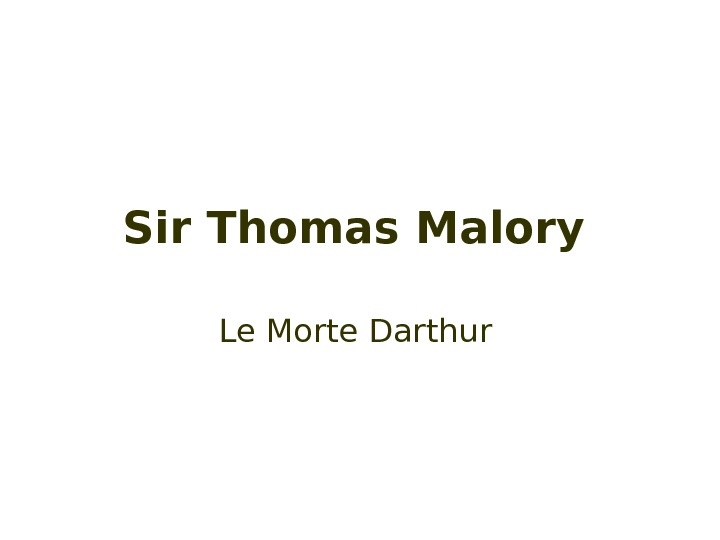


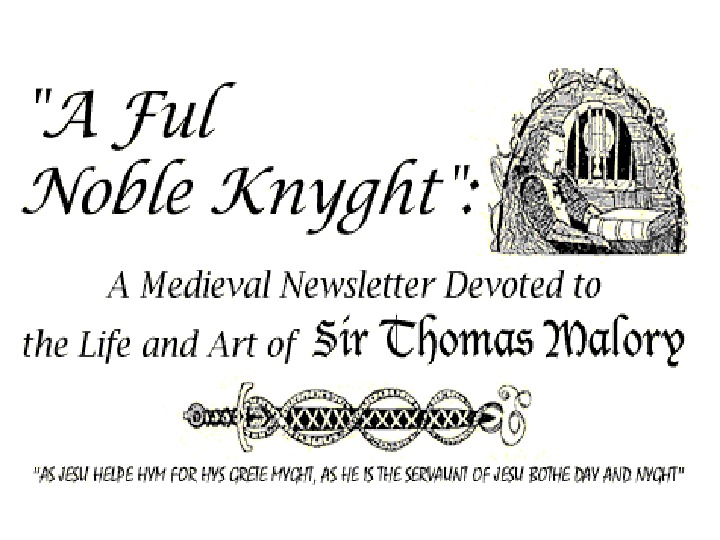
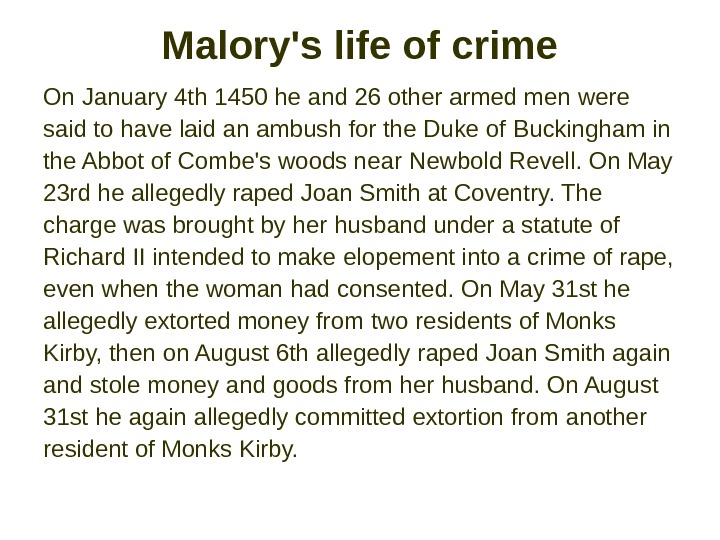



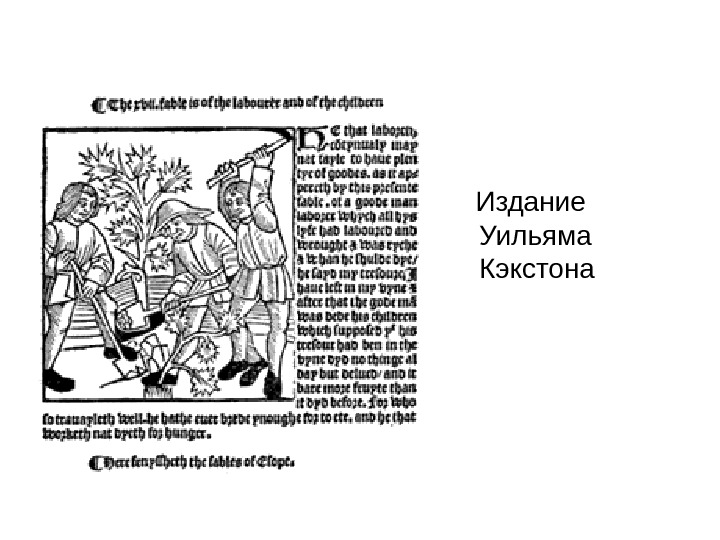



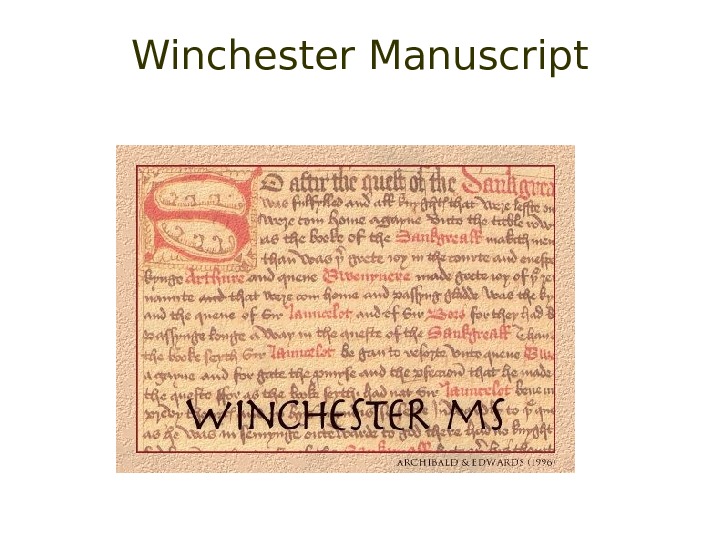
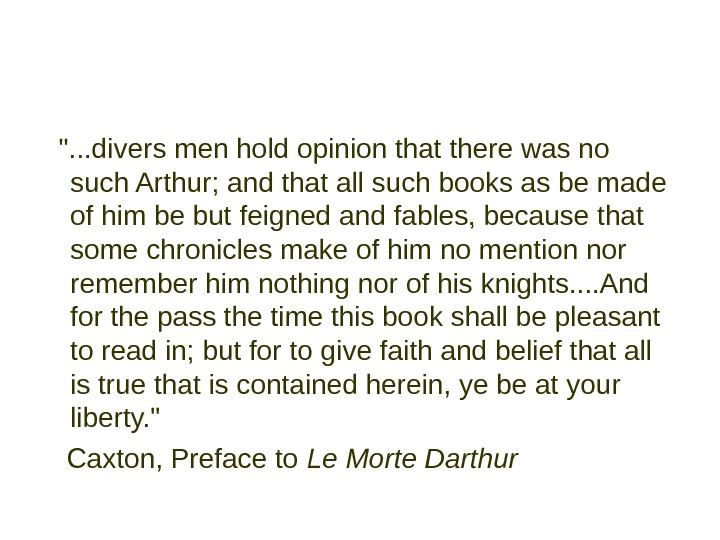












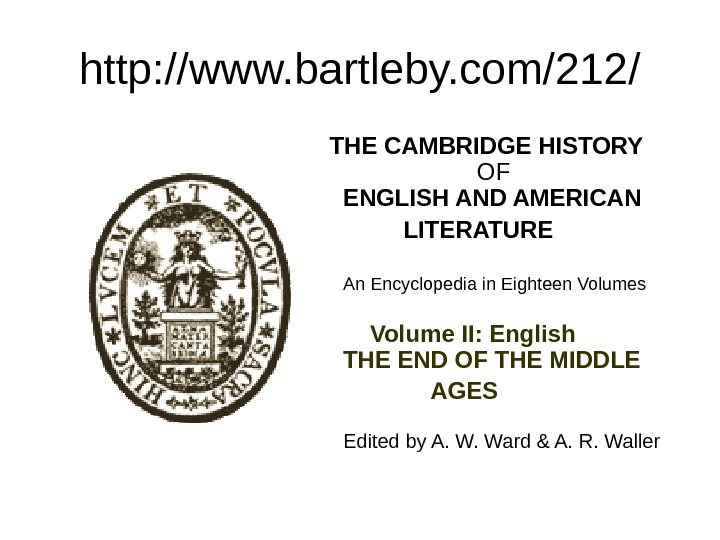



- Размер: 239 Кб
- Количество слайдов: 30
Описание презентации Sir Thomas Malory Le Morte Darthur по слайдам
 Sir Thomas Malory Le Morte Darthur
Sir Thomas Malory Le Morte Darthur
 Sir Thomas Malory (c. 1405 – March 14, 1471) was the author or compiler of Le Morte d’Arthur. The antiquary John Leland (1506– 1552) believed him to be Welsh, but most modern scholarship assumes that he was Sir Thomas Malory of Newbold Revel in Warwickshire. The surname appears in various spellings, including Maillorie , Mallory , Mallery , and Maleore. The name comes from the Old French adjective maleüré (from Latin male auguratus ) meaning ill-omened or unfortunate.
Sir Thomas Malory (c. 1405 – March 14, 1471) was the author or compiler of Le Morte d’Arthur. The antiquary John Leland (1506– 1552) believed him to be Welsh, but most modern scholarship assumes that he was Sir Thomas Malory of Newbold Revel in Warwickshire. The surname appears in various spellings, including Maillorie , Mallory , Mallery , and Maleore. The name comes from the Old French adjective maleüré (from Latin male auguratus ) meaning ill-omened or unfortunate.
 Сэр Т мас М лориоо эо (англ. Sir Thomas Malory ) (ок. 1417— 1471) — английский писатель, автор « Книги о короле Артуре и о его доблестных рыцарях Круглого стола » . Она состоит из восьми романов о Короле Артуре и рыцарях Круглого стола и представляет собой исчерпывающий свод артуровской легенды. В 1485 году английский первопечатник Уильям Кэкстон издал книгу Мэлори под названием «Смерть Артура» (фр. Le Morte Darthur ). Она стала своеобразной энциклопедией артуровского мифа.
Сэр Т мас М лориоо эо (англ. Sir Thomas Malory ) (ок. 1417— 1471) — английский писатель, автор « Книги о короле Артуре и о его доблестных рыцарях Круглого стола » . Она состоит из восьми романов о Короле Артуре и рыцарях Круглого стола и представляет собой исчерпывающий свод артуровской легенды. В 1485 году английский первопечатник Уильям Кэкстон издал книгу Мэлори под названием «Смерть Артура» (фр. Le Morte Darthur ). Она стала своеобразной энциклопедией артуровского мифа.

 Malory’s life of crime On January 4 th 1450 he and 26 other armed men were said to have laid an ambush for the Duke of Buckingham in the Abbot of Combe’s woods near Newbold Revell. On May 23 rd he allegedly raped Joan Smith at Coventry. The charge was brought by her husband under a statute of Richard II intended to make elopement into a crime of rape, even when the woman had consented. On May 31 st he allegedly extorted money from two residents of Monks Kirby, then on August 6 th allegedly raped Joan Smith again and stole money and goods from her husband. On August 31 st he again allegedly committed extortion from another resident of Monks Kirby.
Malory’s life of crime On January 4 th 1450 he and 26 other armed men were said to have laid an ambush for the Duke of Buckingham in the Abbot of Combe’s woods near Newbold Revell. On May 23 rd he allegedly raped Joan Smith at Coventry. The charge was brought by her husband under a statute of Richard II intended to make elopement into a crime of rape, even when the woman had consented. On May 31 st he allegedly extorted money from two residents of Monks Kirby, then on August 6 th allegedly raped Joan Smith again and stole money and goods from her husband. On August 31 st he again allegedly committed extortion from another resident of Monks Kirby.
 • On March 5 th 1451 a warrant was issued for Malory’s arrest and a few weeks later he and various accomplices were alleged to have stolen cattle in Warwickshire. The Duke of Buckingham and 60 men from Warwickshire tried to arrest him but in the meantime Malory apparently raided Buckingham’s hunting lodge, killing deer and doing damage to the property. • He was arrested and imprisoned at Coleshill, but soon escaped (by swimming the moat), then reportedly raided Combe Abbey with a band of one hundred men, breaking down doors, insulting the monks, and stealing money. By January 1452 he was in prison in London, where he spent most of the next eight years waiting for trial. He was bailed out several times and at one point joined a horse-stealing expedition across East Anglia in ended in Colchester jail, from which he escaped too, but was recaptured and taken back to prison in London.
• On March 5 th 1451 a warrant was issued for Malory’s arrest and a few weeks later he and various accomplices were alleged to have stolen cattle in Warwickshire. The Duke of Buckingham and 60 men from Warwickshire tried to arrest him but in the meantime Malory apparently raided Buckingham’s hunting lodge, killing deer and doing damage to the property. • He was arrested and imprisoned at Coleshill, but soon escaped (by swimming the moat), then reportedly raided Combe Abbey with a band of one hundred men, breaking down doors, insulting the monks, and stealing money. By January 1452 he was in prison in London, where he spent most of the next eight years waiting for trial. He was bailed out several times and at one point joined a horse-stealing expedition across East Anglia in ended in Colchester jail, from which he escaped too, but was recaptured and taken back to prison in London.
 William Caxton (c. 1415~1422 – c. March 1492) an English merchant, diplomat, writer and printer. He was the first English person to work as a printer and the first person to introduce a printing press into England. He was also the first English retailer of books (his London contemporaries were all Dutch, German or French).
William Caxton (c. 1415~1422 – c. March 1492) an English merchant, diplomat, writer and printer. He was the first English person to work as a printer and the first person to introduce a printing press into England. He was also the first English retailer of books (his London contemporaries were all Dutch, German or French).
 Издание Уильяма Кэкстона
Издание Уильяма Кэкстона
 Издание Уильяма Кэкстона
Издание Уильяма Кэкстона
 • « Повесть о короле Артуре » (книги 1 -4 по изданию Кэкстона), рассказывающая о происхождении короля Артура, • « Повесть о короле Артуре и императоре Луции » (книга 5), рассказывающая о битве Артура с римлянами и завоевании им римского престола, • « Славная повесть о сэре Ланселоте » (книга 6), • « Книга о сэре Гарете Оркнейском » (книга 7), • « Книга о сэре Тристраме » (книги 7 -12) — обработка сюжета о Тристане и Изольде, • « Повесть о Сангреале, или Подвиг во имя Святого Грааля » (книги 12 -17), • « Книга о сэре Ланселоте и королеве Гиневре » (книги 18 -19), • « Смерть Артура » (книги 20 -21).
• « Повесть о короле Артуре » (книги 1 -4 по изданию Кэкстона), рассказывающая о происхождении короля Артура, • « Повесть о короле Артуре и императоре Луции » (книга 5), рассказывающая о битве Артура с римлянами и завоевании им римского престола, • « Славная повесть о сэре Ланселоте » (книга 6), • « Книга о сэре Гарете Оркнейском » (книга 7), • « Книга о сэре Тристраме » (книги 7 -12) — обработка сюжета о Тристане и Изольде, • « Повесть о Сангреале, или Подвиг во имя Святого Грааля » (книги 12 -17), • « Книга о сэре Ланселоте и королеве Гиневре » (книги 18 -19), • « Смерть Артура » (книги 20 -21).
 Malory’s work had been known only through William Caxton’s printed edition of 1485 for nearly 500 years. However in 1934 a librarian at Winchester College, Walter Oakeshott, discovered this manuscript in a safe in the Warden’s bedroom.
Malory’s work had been known only through William Caxton’s printed edition of 1485 for nearly 500 years. However in 1934 a librarian at Winchester College, Walter Oakeshott, discovered this manuscript in a safe in the Warden’s bedroom.
 • The manuscript was written by two professional scribes working together, some time during the years 1470 to 1483. The most striking feature of the manuscript is its extensive use of red ink
• The manuscript was written by two professional scribes working together, some time during the years 1470 to 1483. The most striking feature of the manuscript is its extensive use of red ink
 Winchester Manuscript
Winchester Manuscript
 «. . . divers men hold opinion that there was no such Arthur; and that all such books as be made of him be but feigned and fables, because that some chronicles make of him no mention nor remember him nothing nor of his knights. . And for the pass the time this book shall be pleasant to read in; but for to give faith and belief that all is true that is contained herein, ye be at your liberty. » Caxton, Preface to Le Morte Darthur
«. . . divers men hold opinion that there was no such Arthur; and that all such books as be made of him be but feigned and fables, because that some chronicles make of him no mention nor remember him nothing nor of his knights. . And for the pass the time this book shall be pleasant to read in; but for to give faith and belief that all is true that is contained herein, ye be at your liberty. » Caxton, Preface to Le Morte Darthur
 In 1934, a manuscript copy of Le Morte Darthur was discovered in the library of Winchester College (and now in the British Library) that is closer to Malory than Caxton’s printed edition of 1485. Neither derives from the other and both are removed from Malory’s original holograph. Curiously, although Caxton did not use the Winchester MS in preparing his printed text, it was in his possession at the time, as can be determined by type smudges on the manuscript. The leaves at the beginning and ending of the Winchester MS are missing, however, and must be supplied by Caxton’s edition, of which there is only a single complete copy.
In 1934, a manuscript copy of Le Morte Darthur was discovered in the library of Winchester College (and now in the British Library) that is closer to Malory than Caxton’s printed edition of 1485. Neither derives from the other and both are removed from Malory’s original holograph. Curiously, although Caxton did not use the Winchester MS in preparing his printed text, it was in his possession at the time, as can be determined by type smudges on the manuscript. The leaves at the beginning and ending of the Winchester MS are missing, however, and must be supplied by Caxton’s edition, of which there is only a single complete copy.
 • It is Caxton who divided the manuscript into books and chapters, making twenty-one books of approximately equal length out of the original four sections. Not all of these
• It is Caxton who divided the manuscript into books and chapters, making twenty-one books of approximately equal length out of the original four sections. Not all of these
 • 23 июля 1934 года в библиотеке винчестерского колледжа библиотекарем У. Оукшоттом был найден манускрипт романа Мэлори, не известный до тех пор и получивший впоследствии название Уинчестерского манускрипта. Оставалось и остается спорным, принадлежит ли этот манускрипт самому Мэлори или это список, сделанный позднее с оставленного писателем оригинала, но было ясно, что роман, дошедший до нас в рукописи, существенно отличаетея от изданного У. Кэкстоном в 1485 г. , как об этом свидетельствовали статьи и сообщения профессора Е. Винавера опубликованные в литературоведческих изданиях 30 -х годов.
• 23 июля 1934 года в библиотеке винчестерского колледжа библиотекарем У. Оукшоттом был найден манускрипт романа Мэлори, не известный до тех пор и получивший впоследствии название Уинчестерского манускрипта. Оставалось и остается спорным, принадлежит ли этот манускрипт самому Мэлори или это список, сделанный позднее с оставленного писателем оригинала, но было ясно, что роман, дошедший до нас в рукописи, существенно отличаетея от изданного У. Кэкстоном в 1485 г. , как об этом свидетельствовали статьи и сообщения профессора Е. Винавера опубликованные в литературоведческих изданиях 30 -х годов.
 Bibliography • Benson, Larry D. Malory’s Morte D ‘ Arthur. Harvard: Harvard University Press, 1976. • Field, P. J. C. The Life and Times of Sir Thomas Malory. Cambridge: D. S. Brewer, 1993. • Lewis, C S. «The English Prose Morte. » Essays on Malory. Ed. J. A. W. Bennett. Oxford: Clarendon Press, 1963. 7 -28.
Bibliography • Benson, Larry D. Malory’s Morte D ‘ Arthur. Harvard: Harvard University Press, 1976. • Field, P. J. C. The Life and Times of Sir Thomas Malory. Cambridge: D. S. Brewer, 1993. • Lewis, C S. «The English Prose Morte. » Essays on Malory. Ed. J. A. W. Bennett. Oxford: Clarendon Press, 1963. 7 -28.
 Bibliography • Bennet, J. A. W. , ed. Essays on Malory. Oxford : Clarendon Press, 1963. • Benson, Larry D. Malory’s Morte D ‘Arthur. Cambridge: Harvard University Press, 1976. • Field, P. J. C. Romance and Chronicle: A Study of Malory’s Prose Style. London: Barrie and Jenkins, 1971.
Bibliography • Bennet, J. A. W. , ed. Essays on Malory. Oxford : Clarendon Press, 1963. • Benson, Larry D. Malory’s Morte D ‘Arthur. Cambridge: Harvard University Press, 1976. • Field, P. J. C. Romance and Chronicle: A Study of Malory’s Prose Style. London: Barrie and Jenkins, 1971.
 Bibliography • Hodges, Margaret. Knight Prisoner: The Tale of Sir Thomas Malory and His King Arthur. New York: Ferrar, Straus and Giroux, 1976. • Lambert, Mark. Malory: Style and Vision in the Morte Darthur. New Haven: Yale University Press, 1975. • Lumiansky, R. M. , ed. Malory’s Originality: A Critical Study of Le Morte Darthur. Baltimore: Johns Hopkins Press, 1964.
Bibliography • Hodges, Margaret. Knight Prisoner: The Tale of Sir Thomas Malory and His King Arthur. New York: Ferrar, Straus and Giroux, 1976. • Lambert, Mark. Malory: Style and Vision in the Morte Darthur. New Haven: Yale University Press, 1975. • Lumiansky, R. M. , ed. Malory’s Originality: A Critical Study of Le Morte Darthur. Baltimore: Johns Hopkins Press, 1964.
 Bibliography • Matthews, William. The ill Framed Knight: A Skeptical Inquiry into the Identity of Sir Thomas Malory. University of California Press: Berkeley, 1966. • Mc. Carthy, Terence. An Introduction to Malory. Cambridge: D. S. Brewer, 1994.
Bibliography • Matthews, William. The ill Framed Knight: A Skeptical Inquiry into the Identity of Sir Thomas Malory. University of California Press: Berkeley, 1966. • Mc. Carthy, Terence. An Introduction to Malory. Cambridge: D. S. Brewer, 1994.
 Bibliography • Vinaver, Eugene. Malory. Oxford: Clarendon Press, 1929. Vinaver is, in may ways, the father of Malory scholarship. His name deserves to stand by that of Caxton’s as the first modern editor of Malory’s works. Although his assessment of Malory’s accomplishments is overly critical, overemphasizing his supposed misunderstanding of the chivalric tradition, Vinaver provides his readers with an excellent source study of the Morte.
Bibliography • Vinaver, Eugene. Malory. Oxford: Clarendon Press, 1929. Vinaver is, in may ways, the father of Malory scholarship. His name deserves to stand by that of Caxton’s as the first modern editor of Malory’s works. Although his assessment of Malory’s accomplishments is overly critical, overemphasizing his supposed misunderstanding of the chivalric tradition, Vinaver provides his readers with an excellent source study of the Morte.
 Bibliography • Reiss, Edmund. Sir Thomas Malory. New York: Twayne, 1966. Perhaps the best introduction to Malory. Reiss not only explores the subtleties of each tale, but outlines them in such a way as to give the reader a sense of the background of Malory scholarship. His understanding of the critical issues involved in each tale make this an indispensible guide and companion to the Arthurian world for both newcomers and seasoned veterans alike.
Bibliography • Reiss, Edmund. Sir Thomas Malory. New York: Twayne, 1966. Perhaps the best introduction to Malory. Reiss not only explores the subtleties of each tale, but outlines them in such a way as to give the reader a sense of the background of Malory scholarship. His understanding of the critical issues involved in each tale make this an indispensible guide and companion to the Arthurian world for both newcomers and seasoned veterans alike.
 «Sir Thomas Malory» by E. Reiss «In the present work I have tried. . . to provide a commentary on Malory’s work that is primarily concerned with how it functions as a work of literary art. I could have proceeded by analyzing according to subject; for example, one chapter on Malory’s idea о n chivalry, another on his concept of love, and s о forth. Such a method is valuable, and many recent studies have approached the «Morte Arthur» in this way. Instead I have preferred to discuss the work as it stands and to show Malory’s concepts as they arise and function in his developing narrative. «
«Sir Thomas Malory» by E. Reiss «In the present work I have tried. . . to provide a commentary on Malory’s work that is primarily concerned with how it functions as a work of literary art. I could have proceeded by analyzing according to subject; for example, one chapter on Malory’s idea о n chivalry, another on his concept of love, and s о forth. Such a method is valuable, and many recent studies have approached the «Morte Arthur» in this way. Instead I have preferred to discuss the work as it stands and to show Malory’s concepts as they arise and function in his developing narrative. «
 D. S. Brewer • THE PRESENT STUDY OF MALORY • Form in the ‘Morte Darthur’
D. S. Brewer • THE PRESENT STUDY OF MALORY • Form in the ‘Morte Darthur’
 D. S. Brewer «. . . what does justify him (Caxton’s) — and us – in emphasizing the unity о f the work, is its own construction and its own words. «
D. S. Brewer «. . . what does justify him (Caxton’s) — and us – in emphasizing the unity о f the work, is its own construction and its own words. «
 http: //www. bartleby. com/212/ THE CAMBRIDGE HISTORY OF ENGLISH AND AMERICAN LITERATURE An Encyclopedia in Eighteen Volumes Volume II: English THE END OF THE MIDDLE AGES Edited by A. W. Ward & A. R. Waller
http: //www. bartleby. com/212/ THE CAMBRIDGE HISTORY OF ENGLISH AND AMERICAN LITERATURE An Encyclopedia in Eighteen Volumes Volume II: English THE END OF THE MIDDLE AGES Edited by A. W. Ward & A. R. Waller

 • CHAPTER I How Uther Pendragon sent for the duke of Cornwall and Igraine his wife, and of their departing suddenly again. IT befell in the days of Uther Pendragon, when he was king of all England, and so reigned, that there was a mighty duke in Cornwall that held war against him long time. And the duke was called the Duke of Tintagil. And so by means King Uther sent for this duke, charging him to bring his wife with him, for she was called a fair lady, and a passing wise, and her name was called Igraine. So when the duke and his wife were come unto the king, by the means of great lords they were accorded both. The king liked and loved this lady well, and he made them great cheer out of measure, and desired to have lain by her. But she was a passing good woman, and would not assent unto the king. And then she told the duke her husband, and said, I suppose that we were sent for that I should be dishonoured; wherefore, husband, I counsel you, that we depart from hence suddenly, that we may ride all night unto our own castle. And in like wise as she said so they departed, that neither the king nor none of his council were ware of their departing. All so soon as King Uther knew of their departing so suddenly, he was wonderly wroth. Then he called to him his privy council, and told them of the sudden departing of the duke and his wife.
• CHAPTER I How Uther Pendragon sent for the duke of Cornwall and Igraine his wife, and of their departing suddenly again. IT befell in the days of Uther Pendragon, when he was king of all England, and so reigned, that there was a mighty duke in Cornwall that held war against him long time. And the duke was called the Duke of Tintagil. And so by means King Uther sent for this duke, charging him to bring his wife with him, for she was called a fair lady, and a passing wise, and her name was called Igraine. So when the duke and his wife were come unto the king, by the means of great lords they were accorded both. The king liked and loved this lady well, and he made them great cheer out of measure, and desired to have lain by her. But she was a passing good woman, and would not assent unto the king. And then she told the duke her husband, and said, I suppose that we were sent for that I should be dishonoured; wherefore, husband, I counsel you, that we depart from hence suddenly, that we may ride all night unto our own castle. And in like wise as she said so they departed, that neither the king nor none of his council were ware of their departing. All so soon as King Uther knew of their departing so suddenly, he was wonderly wroth. Then he called to him his privy council, and told them of the sudden departing of the duke and his wife.
 Случилось так во времена Утера Пендрагона, когда он был королем и властвовал над всей Английской землей, что жил тогда в Корнуэлле могучий герцог, который вел с ним долгую войну, а звался тот герцогом Тинтагильским. Раз послал король Утер за этим герцогом и повелел ему явиться и привезти с собой жену, ибо о ней говорили, что она прекрасна собой и замечательно мудра, звали же ее Игрейна. И когда герцог со своей женой предстали перед королем, то стараниями баронов примирились они друг с другом. Королю очень приглянулась и полюбилась та женщина, и он приветствовал их и принял у себя с чрезвычайным радушием и пожелал возлечь с нею, но она была женщина весьма добродетельная и не уступила королю. И тогда сказала она герцогу, своему мужу: — Видно, нас пригласили сюда, чтобы меня обесчестить. А потому, супругой, прошу вас, давайте сей же час уедем отсюда, тогда мы за ночь успеем доскакать до нашего замка. Как она сказала, так они и сделали, и отбыли тайно, и ни сам король и никто из его приближенных не подозревал об их отъезде. Но как только король Утер узнал об их столь внезапном отъезде, разгневался он ужасно; он призвал к себе своих тайных советников и поведал им о внезапном отъезде герцога с женою.
Случилось так во времена Утера Пендрагона, когда он был королем и властвовал над всей Английской землей, что жил тогда в Корнуэлле могучий герцог, который вел с ним долгую войну, а звался тот герцогом Тинтагильским. Раз послал король Утер за этим герцогом и повелел ему явиться и привезти с собой жену, ибо о ней говорили, что она прекрасна собой и замечательно мудра, звали же ее Игрейна. И когда герцог со своей женой предстали перед королем, то стараниями баронов примирились они друг с другом. Королю очень приглянулась и полюбилась та женщина, и он приветствовал их и принял у себя с чрезвычайным радушием и пожелал возлечь с нею, но она была женщина весьма добродетельная и не уступила королю. И тогда сказала она герцогу, своему мужу: — Видно, нас пригласили сюда, чтобы меня обесчестить. А потому, супругой, прошу вас, давайте сей же час уедем отсюда, тогда мы за ночь успеем доскакать до нашего замка. Как она сказала, так они и сделали, и отбыли тайно, и ни сам король и никто из его приближенных не подозревал об их отъезде. Но как только король Утер узнал об их столь внезапном отъезде, разгневался он ужасно; он призвал к себе своих тайных советников и поведал им о внезапном отъезде герцога с женою.

